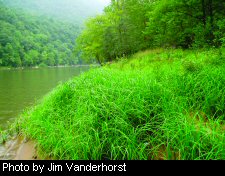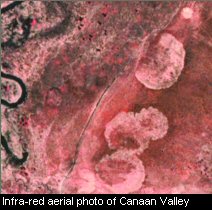

Sedges Have The EdgesBy Jim Vanderhorst
Some plants known as sedges are found in other genera, however. For example, nut sedges and three-way sedge belong to the same family as Carex but are in different genera. Broomsedge actually belongs to the grass family. Most sedges, however, belong to the genus Carex . There are about 2,000 species of Carex in the world. A recent count indicates 134 species of Carex exist in West Virginia , making it the largest genus (including all plants, animals, fungi, and microbes) known in the state. My dictionary defines sedge as a “coarse, grass-like plant growing in wet ground,” but this definition underestimates the broad range of sedge morphologies and habitats. Sedges are similar to grasses in many ways. Like grasses, they are herbs that usually have long, narrow leaves with parallel veins and inconspicuous flowers. Unlike most grasses, sedges in the genus Carex are almost always monoecious (from the Greek, meaning one dwelling).This means that they have separate female and male flowers that are born on the same plant. Species of Carex are best Species of Carex grow in many habitats, not just “in wet ground.” Some are dominant in wetlands and others on dry hillsides. There is often a surprisingly high diversity of Carex species in upland deciduous forests. Individual species are often good indicators of environmental conditions including soil chemistry and moisture, light level, and elevation. Sedges provide many ecological and economic benefits. They hold riverbanks and help cleanse polluted water. They serve as shelter and food for wildlife. They provide forage for livestock. But perhaps the greatest value of sedges is the wonderment in diversity that they provide those people who choose to be interested. Jim Vanderhorst is a DNR ecologist stationed in Elkins. |
 Carex is the largest genus of organisms in West Virginia . A genus is a group of closely related species. Differences between species in the same genus are smaller than differences between species of different genera. Species of Carex are plants commonly called sedges.
Carex is the largest genus of organisms in West Virginia . A genus is a group of closely related species. Differences between species in the same genus are smaller than differences between species of different genera. Species of Carex are plants commonly called sedges.  characterized by having a sac-like structure, the perigynium, which encloses the female flower and developing seed. The taxonomy of the genus is based mostly on the reproductive features including the arrangement of female and male flowers on the plant and the size, shape and texture of the perigynia. Species also differ in vegetative features including the size, color, and arrangement of leaves and the habit and longevity of individual plants. Some are relatively “coarse” plants, some are small and delicate.
characterized by having a sac-like structure, the perigynium, which encloses the female flower and developing seed. The taxonomy of the genus is based mostly on the reproductive features including the arrangement of female and male flowers on the plant and the size, shape and texture of the perigynia. Species also differ in vegetative features including the size, color, and arrangement of leaves and the habit and longevity of individual plants. Some are relatively “coarse” plants, some are small and delicate.